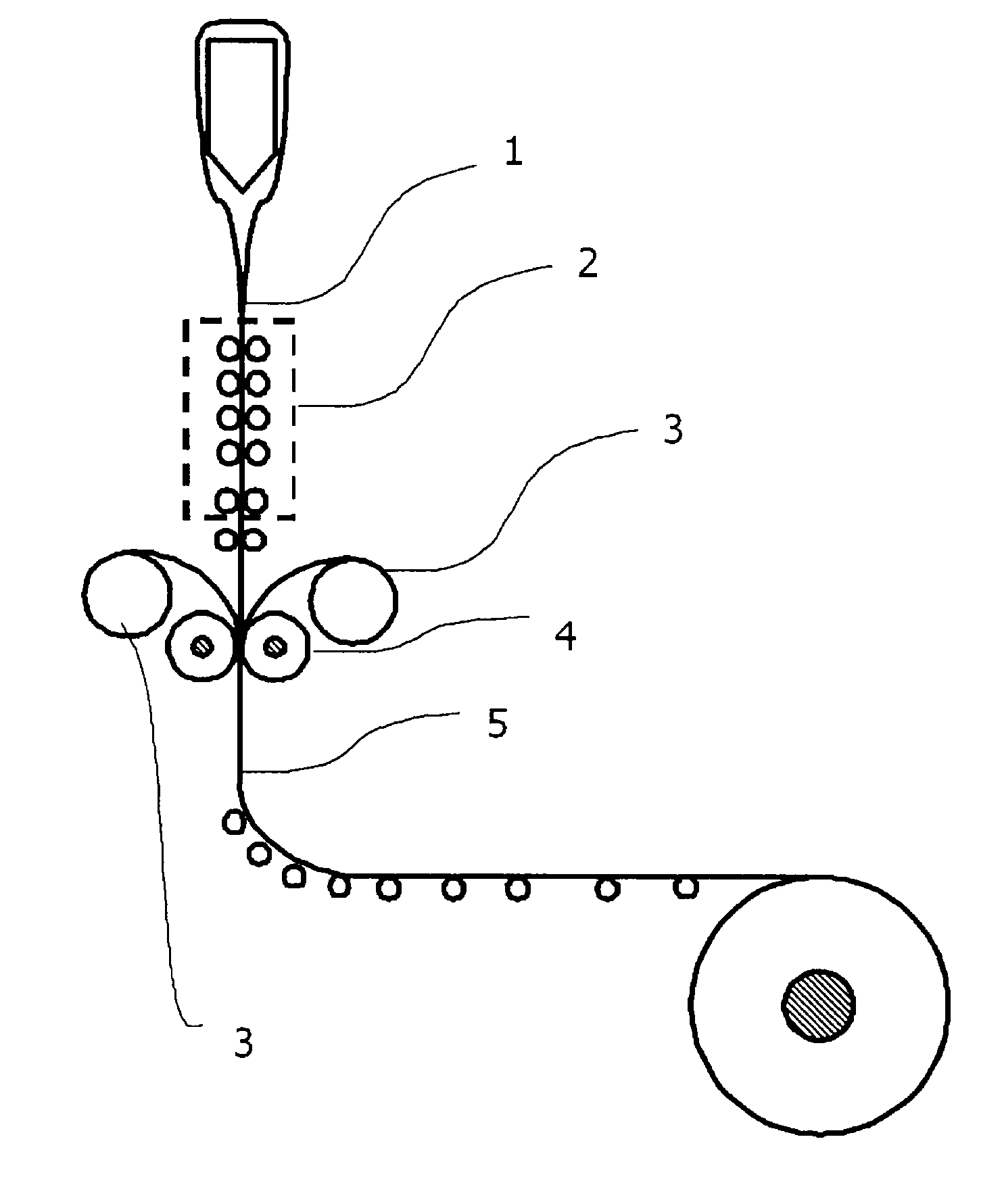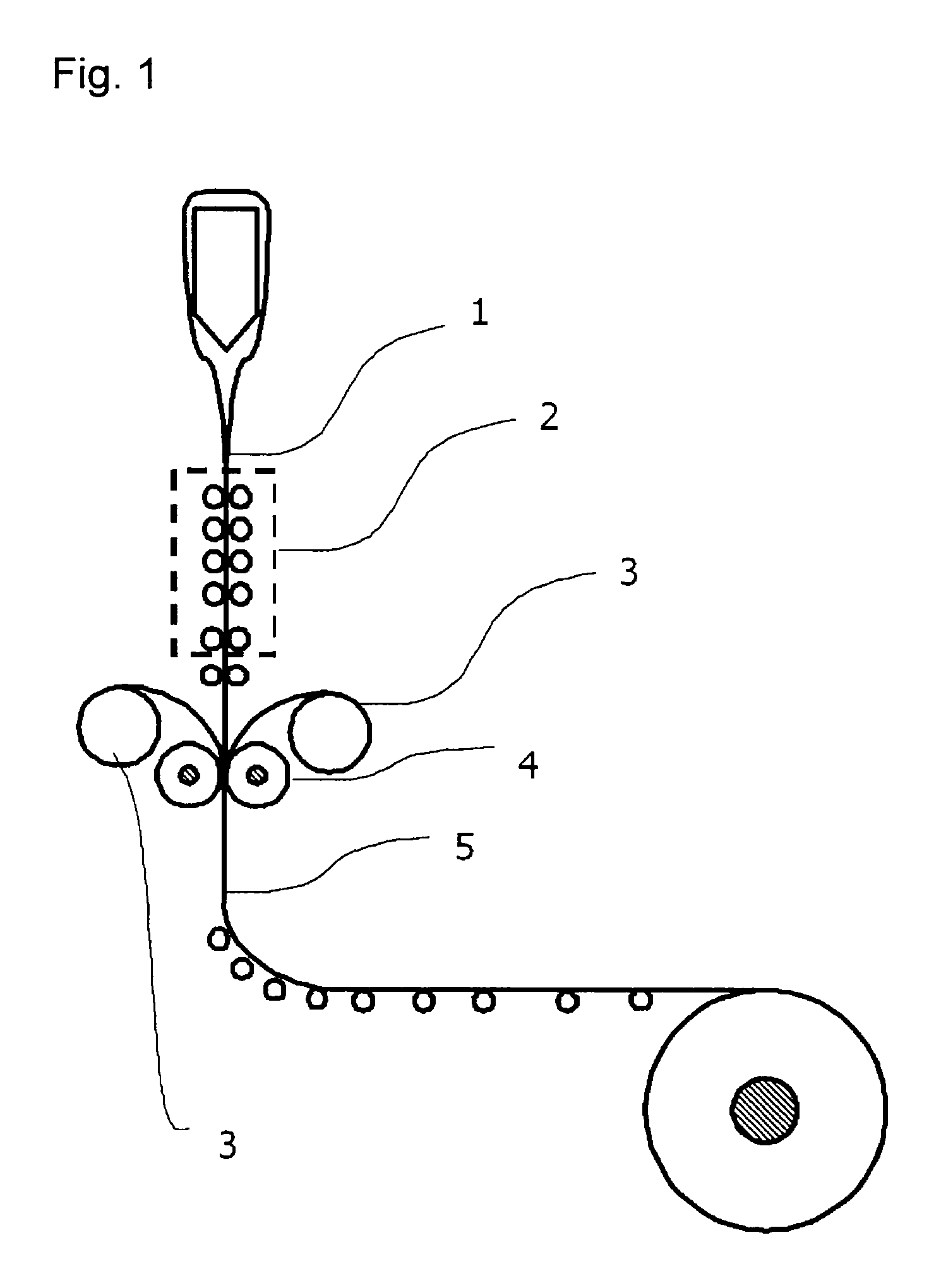Process for producing glass/resin composite
a technology of glass/resin and composites, applied in the field of glass/resin composite production, can solve the problems of insufficient mechanical strength and difficult handling of glass surfaces, and achieve the effects of reducing high mechanical strength, and reducing the possibility of physical damage on glass surfaces
- Summary
- Abstract
- Description
- Claims
- Application Information
AI Technical Summary
Benefits of technology
Problems solved by technology
Method used
Image
Examples
example 1
[0064]An example of the present invention is described with reference to FIG. 1.
[0065]A glass ribbon 1 (AN100, manufactured by Asahi Glass Company, Limited) having a linear expansion coefficient of 38×10−7 / ° C. was formed into a thickness of 100 μm by a conventionally known fusion method, followed by cooling to around 120° C. at a slowly cooling part 2. Then, resin films (polyethylene terephthalate film) 3 having a thickness of 50 μm were lamented on both surfaces of the glass ribbon 1 via a urethane hot melt adhesive layer (thickness: 30 μm, melting point: 120° C.; not shown on drawings) by using a nip roller 4 adjusted to 120° C. to obtain glass / resin composite 5.
example 2
[0068]An Example of the present invention is described with reference to FIG. 2. A glass ribbon 1 (AN100, manufactured by Asahi Glass Company, Limited) having a linear expansion coefficient of 38×10−7 / ° C. was formed into a thickness of 100 μm by a conventionally known fusion method and slowly cooled to around normal temperature (hereinafter, normal temperature means about 20° C.). A resin film (polyethylene terephthalate film) 3 having a thickness of 50 μm was laminated on one surface of the glass ribbon 1 via an acrylic adhesive layer (not shown on the figure) by using a nip roller 4 to obtain a glass / resin composite 5.
example 3
[0069]An example of the present invention is described with reference to FIG. 3. A glass ribbon 1 (AN100, manufactured by Asahi Glass Company, Limited) having a linear expansion coefficient of 38×10−7 / ° C. was formed into a thickness of 100 μm by a conventionally known fusion method. When the surface temperature of the glass ribbon 1 was 300° C. in the slowly cooling part 2, a thermoplastic polyimide resin film 3 (Aurum film, manufactured by Mitsui Chemicals, Inc., glass transition point: 250° C.) having a thickness of 50 μm was heat melt-fixed on one surface of the glass ribbon 1 by using a nip roller 4 to obtain a glass / resin composite.
PUM
| Property | Measurement | Unit |
|---|---|---|
| thickness | aaaaa | aaaaa |
| thickness | aaaaa | aaaaa |
| thickness | aaaaa | aaaaa |
Abstract
Description
Claims
Application Information
 Login to View More
Login to View More - R&D
- Intellectual Property
- Life Sciences
- Materials
- Tech Scout
- Unparalleled Data Quality
- Higher Quality Content
- 60% Fewer Hallucinations
Browse by: Latest US Patents, China's latest patents, Technical Efficacy Thesaurus, Application Domain, Technology Topic, Popular Technical Reports.
© 2025 PatSnap. All rights reserved.Legal|Privacy policy|Modern Slavery Act Transparency Statement|Sitemap|About US| Contact US: help@patsnap.com



